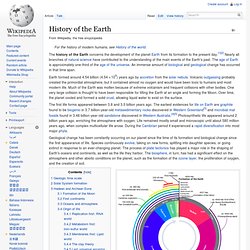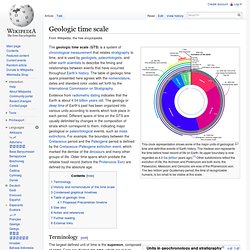

History of the Earth. The history of the Earth concerns the development of the planet Earth from its formation to the present day.[1][2] Nearly all branches of natural science have contributed to the understanding of the main events of the Earth's past.

The age of Earth is approximately one-third of the age of the universe. An immense amount of biological and geological change has occurred in that time span. The first life forms appeared between 3.8 and 3.5 billion years ago. The earliest evidences for life on Earth are graphite found to be biogenic in 3.7 billion-year-old metasedimentary rocks discovered in Western Greenland[3] and microbial mat fossils found in 3.48 billion-year-old sandstone discovered in Western Australia.[4][5] Photosynthetic life appeared around 2 billion years ago, enriching the atmosphere with oxygen. Life remained mostly small and microscopic until about 580 million years ago, when complex multicellular life arose. Geologic time scale[edit] Millions of Years First continents[edit] Geologic time scale. The geologic time scale (GTS) is a system of chronological measurement that relates stratigraphy to time, and is used by geologists, paleontologists, and other earth scientists to describe the timing and relationships between events that have occurred throughout Earth's history.

The table of geologic time spans presented here agrees with the nomenclature, dates and standard color codes set forth by the International Commission on Stratigraphy. Evidence from radiometric dating indicates that the Earth is about 4.54 billion years old. The geology or deep time of Earth's past has been organized into various units according to events which took place in each period. Different spans of time on the GTS are usually delimited by changes in the composition of strata which correspond to them, indicating major geological or paleontological events, such as mass extinctions. Terminology[edit] History and nomenclature of the time scale[edit] Graphical representation of Earth's history as a spiral. List of periods and events in climate history. Knowledge of precise climatic events decreases as the record goes further back in time.

Some notable climate events known to Paleoclimatology are listed here. The Timeline of glaciation covers ice ages specifically, which tend to have their own names for phases, often with different names used for different parts of the world. The names for earlier periods and events come from geology and paleontology. The Marine isotope stages (MIS) are often used to express dating within the Quaternary. Start to Quaternary period[edit] 500 million years of climate change Ice core data for the past 400,000 years, with the present at left. Scale: Millions of years before present, earlier dates approximate. Pleistocene[edit] All dates are approximate. Holocene[edit] All dates are BC (BCE) and approximate. Common Era/AD[edit] See also[edit] Climate across Cretaceous-Paleogene boundary. Paleoclimatology. History[edit] The scientific study field of paleoclimate begun to form in the early 19th century, when discoveries about glaciations and natural changes in Earth's climate past helped to identify the process of the greenhouse effect.

Reconstructing ancient climates[edit] Palaeotemperature graphs compressed together Paleoclimatologists employ a wide variety of techniques to deduce ancient climates. Ice[edit] Mountain glaciers and the polar ice caps/ice sheets provide much data in paleoclimatology. Air trapped within fallen snow becomes encased in tiny bubbles as the snow is compressed into ice in the glacier under the weight of later years' snow. Dendroclimatology[edit] Climatic information can be obtained through an understanding of changes in tree growth. On a longer time scale, geologists must refer to the sedimentary record for data. Sedimentary content Sea floor core sample labelled to identify the exact spot on the sea floor where the sample was taken.
Sedimentary facies Limitations[edit]